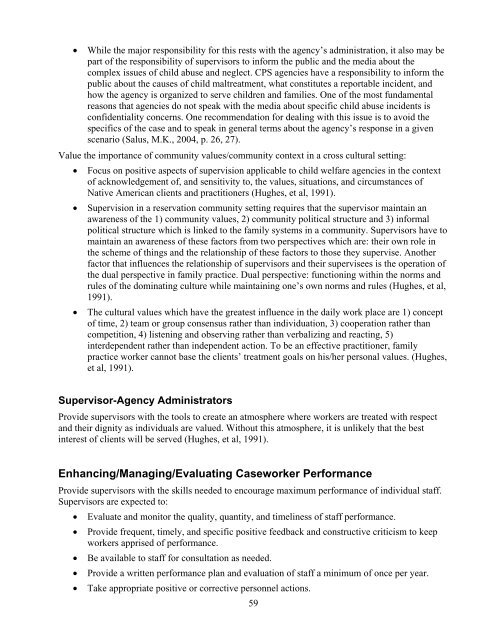Building a Model and Framework for Child Welfare Supervision
Building a Model and Framework for Child Welfare Supervision
Building a Model and Framework for Child Welfare Supervision
- No tags were found...
Create successful ePaper yourself
Turn your PDF publications into a flip-book with our unique Google optimized e-Paper software.
• While the major responsibility <strong>for</strong> this rests with the agency’s administration, it also may bepart of the responsibility of supervisors to in<strong>for</strong>m the public <strong>and</strong> the media about thecomplex issues of child abuse <strong>and</strong> neglect. CPS agencies have a responsibility to in<strong>for</strong>m thepublic about the causes of child maltreatment, what constitutes a reportable incident, <strong>and</strong>how the agency is organized to serve children <strong>and</strong> families. One of the most fundamentalreasons that agencies do not speak with the media about specific child abuse incidents isconfidentiality concerns. One recommendation <strong>for</strong> dealing with this issue is to avoid thespecifics of the case <strong>and</strong> to speak in general terms about the agency’s response in a givenscenario (Salus, M.K., 2004, p. 26, 27).Value the importance of community values/community context in a cross cultural setting:• Focus on positive aspects of supervision applicable to child welfare agencies in the contextof acknowledgement of, <strong>and</strong> sensitivity to, the values, situations, <strong>and</strong> circumstances ofNative American clients <strong>and</strong> practitioners (Hughes, et al, 1991).• <strong>Supervision</strong> in a reservation community setting requires that the supervisor maintain anawareness of the 1) community values, 2) community political structure <strong>and</strong> 3) in<strong>for</strong>malpolitical structure which is linked to the family systems in a community. Supervisors have tomaintain an awareness of these factors from two perspectives which are: their own role inthe scheme of things <strong>and</strong> the relationship of these factors to those they supervise. Anotherfactor that influences the relationship of supervisors <strong>and</strong> their supervisees is the operation ofthe dual perspective in family practice. Dual perspective: functioning within the norms <strong>and</strong>rules of the dominating culture while maintaining one’s own norms <strong>and</strong> rules (Hughes, et al,1991).• The cultural values which have the greatest influence in the daily work place are 1) conceptof time, 2) team or group consensus rather than individuation, 3) cooperation rather thancompetition, 4) listening <strong>and</strong> observing rather than verbalizing <strong>and</strong> reacting, 5)interdependent rather than independent action. To be an effective practitioner, familypractice worker cannot base the clients’ treatment goals on his/her personal values. (Hughes,et al, 1991).Supervisor-Agency AdministratorsProvide supervisors with the tools to create an atmosphere where workers are treated with respect<strong>and</strong> their dignity as individuals are valued. Without this atmosphere, it is unlikely that the bestinterest of clients will be served (Hughes, et al, 1991).Enhancing/Managing/Evaluating Caseworker Per<strong>for</strong>manceProvide supervisors with the skills needed to encourage maximum per<strong>for</strong>mance of individual staff.Supervisors are expected to:• Evaluate <strong>and</strong> monitor the quality, quantity, <strong>and</strong> timeliness of staff per<strong>for</strong>mance.• Provide frequent, timely, <strong>and</strong> specific positive feedback <strong>and</strong> constructive criticism to keepworkers apprised of per<strong>for</strong>mance.• Be available to staff <strong>for</strong> consultation as needed.• Provide a written per<strong>for</strong>mance plan <strong>and</strong> evaluation of staff a minimum of once per year.• Take appropriate positive or corrective personnel actions.59
















